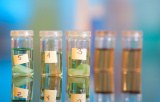
Fixatives
The purpose of fixation is to preserve the structures and to cure the samples. It must be done immediately after sampling, by immersing the material in a large volume of fixing liquid. The most commonly used fixing fluids are formalin or Bouin's liquid (a mixture of formaldehyde and picric acid). The duration of the fixation varies according to the volume of the samples (from a few hours for a small biopsy fragment to several weeks for an entire human brain).
Since the fixation is intended to immobilize the cellular and tissue structures in a state as close as possible to their living state, the fixative must have a rapid and homogeneous penetration, give no tissue retraction, reveal intracellular organelles and structures latent, avoid the displacement of soluble constituents, such as glycogen, preserve the activity of certain enzymes, and in principle allow to find the visible elements on the vital staining. To summarize, the fixation should not create artifacts and ensure the preservation and accurate image of tissue and cells.
There are 2 varieties of fixatives:
- those which penetrate rapidly and fix slowly, like Formol,
- those who penetrate slowly and fix quickly like the Bouin.
Also, Formol is best suited for large pieces while the Bouin is suitable for small pieces.




